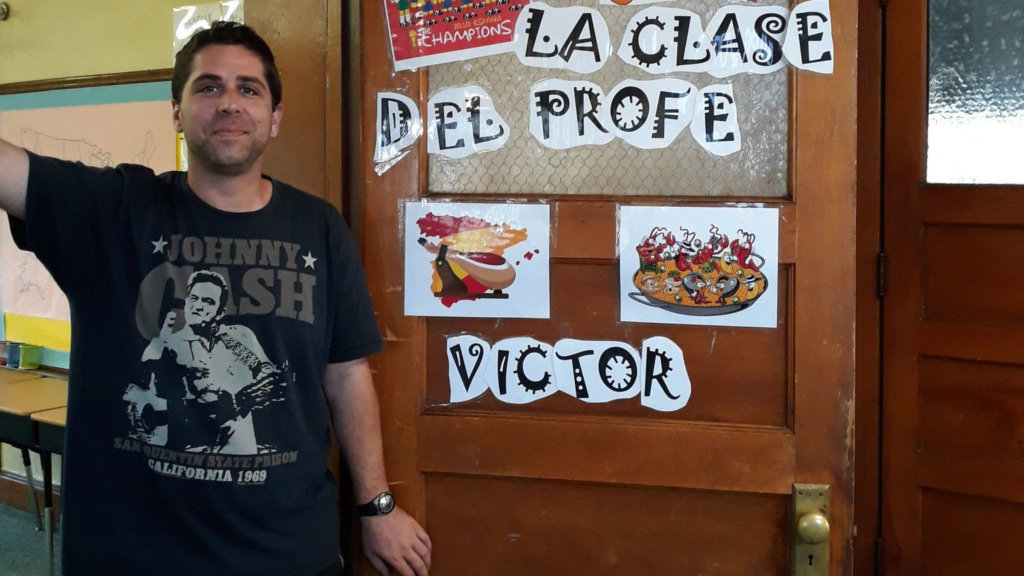Hi, my name is Víctor Holgado Maján, and I am going to tell you about my experience as a Visiting Teacher in the United States, specifically in the state of Massachusetts, where I teach in Spanish the subjects of Spanish Language, Mathematics and Science in a public dual-education school.
I embarked on this adventure to enrich myself as a person, to get to know a new culture, as well as a new educational system.
I come from a charter school in Madrid, where the socioeconomic level of the families is medium/high, and I found myself living in a town of forty thousand inhabitants called Holyoke, located in the western part of the state. Almost half of the population is of Puerto Rican origin, which makes the teaching of Spanish in their schools quite coherent.
The state is divided into school districts, and I work in the poorest of all, where families are of a low socioeconomic level, which results in a lack of public funds to obtain resources.
I embarked on this adventure to enrich myself as a person, to know a new culture, as well as a new educational system.
In the United States there are three types of schools: private, charter and public. The funds to finance the last one depend on the results that each school obtains in the state exams called MCAS, which causes added pressure for both teachers and students starting from third grade to High School. In my case, I am teaching fourth grade, and the preparation for these, and other state tests during the year is vital for the promotion of the teacher, although from the management team they tell you otherwise to calm down.
Huge classrooms
Apart from these tests, all public schools have district supervisors, advisors within the centers, principals of the centers themselves and the superintendent of each district, who comes two or three times a month to enter your class and evaluate your work as a teacher. Personally, it does not seem too bad, since they are very polite and try to go unnoticed when they enter the classroom while you teach. After each visit they present a feedback, which is always positive, to help you improve your teaching, according to what they consider appropriate.
The school where I work ranges from Preschool (3 years old) to fifth grade. This last one will be created next year, as the oldest students are in fourth grade. It is a school with two rooms per grade, in which the average ratio is 20 students. The Dual program is developed in the following way: each teacher is assigned a grade, which consists of two groups. Each grade has two teachers, one for the English part, and one for the Spanish. In my personal case, in the morning I have a group, and in the afternoon the other, with which I repeat the same lesson twice a day.
Regarding the methodology in this school, it is totally different to what I have been used to in Spain (Games Based Learning, gamification, project work, etc …). Here, and I repeat, is my personal case, soft skills, such as cooperation between colleagues, teamwork and humility are working little. I had a hard time introducing projects as a team, since learning tends to be more individualistic.
Regarding the freedom of teaching, from the management team they tell you very politely that you conform to their methods (reading, writing, mathematics, work by centers, etc …), so you do not have a wide margin to vary their methodologies . I will make a small emphasis on work by centers.
The classrooms are huge, where you can create different learning corners without any space problem compared to Spain.
Work by centers is the cornerstone of the educational system in the United States. It is about that, the teacher divides the students into groups of level, for the subjects of Reading and Writing, and Mathematics. In my personal case, I have four groups. While three of the four are doing independent work (worksheets, board games or digital games related to the curriculum), the teacher stays with the other group to carry out a closer and individualized learning.
Ubiquitous technology
All the classrooms have smart boards, Smart TV, Ipads in the lower courses and two carts of 30 Chromebooks in the higher courses. Besides, teachers are provided with a working laptop.
Particularly, the digital resources of this school are greater than in the school where I worked before, but on the other hand, it’s only use is ludic, and since there is no computer subject, the school does not have a content plan to develop the digital competence in the classroom.
Finally, and very importantly, the school environment is fantastic and very familiar (it may be because it is a small school). Both management team and colleagues are always willing to lend a hand in whatever it takes. During the week, five coordination hours are allocated to the week (within your schedule). If a teacher is missing, the district automatically and efficiently provides substitutes so that your planning hours are respected. Also highlight the fulfillment of the schedule without doing more hours.
All this being said, the first two months were quite hard, in which you have to adapt to a new way of teaching life, but once you pick up the pace, the workload is less, and that’s when your real life begins. Experience.
Watch Victor’s video from the Malasaña Innobar


